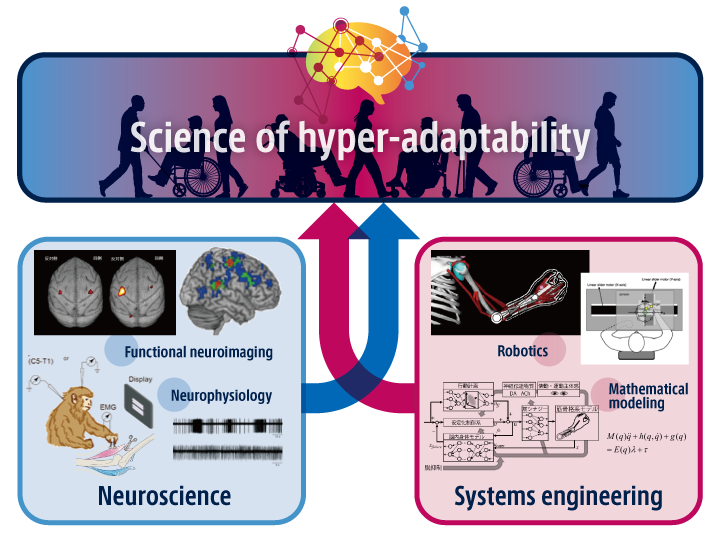| Term of Project | FY 2019-2023 |
|---|---|
| Title of Project | Hyper-adaptability for overcoming body-brain dysfunction: Integrated empirical and system theoretical approaches |
| Abbreviation | Hyper-adaptability (Research Project Number: 8102) |
| Head Investigator | Jun OTA – Professor, Research into Artifacts, Center for Engineering (RACE), School of Engineering, The University of Tokyo |

Purpose of the Research Project
With coming of a super-aging society in Japan, we are facing the urgent problems of sensory-motor impairments, declining higher-order brain functions, cognitive impairment, loss of motivation, and mood disorders caused by aging, and in turn extreme decline of bodily and neurological functions. All of these problems have a common source: inability to adapt appropriately to a brain-body system changed with aging and impairments.
The human body has a high degree of redundancy. For example, “when a hand is paralyzed by a spinal cord injury, the ipsilateral motor cortex immediately joins its control by reactivating its pre-existing neural pathway, which is normally suppressed and preserved in the course of development” (Isa, 2019).
In light of such facts, we believe that clarifying the brain’s “hyper-adaptability” may resolve the abovementioned issues.
The goal of our research project is to elucidate the neural and computational principles of hyper-adaptability in which the brain manages impairment of brain functions by linking neuroscience with systems engineering in order to comprehensively understand acute/chronic impairments and disorders, and the principle of frailty.
Content of the Research Project
When a person experiences acute/chronic impairment or disorder due to aging, the brain reorganizes neural networks by disinhibiting pre-existing neural network that is normally suppressed and searching for latent but available network that has long been unutilized through course of evolution and development. We call this process of functional compensation as “reconstruction of neural structure”, i.e. a neural entity that achieves hyper-adaptability. In order to implement practical functions to this reconstituted neural network, the network should acquire a new control policy of motor effectors based on precise recognition of the present states of the brain and the body. Here, the brain has to activate the new network by repeatedly performing neural computations and updates the network based on prediction error. We call this learning cycle in a new control space as “reconstitution of sensorimotor control rules”, i.e. neural computation principle that enables hyper-adaptability.
In order to verify the hypotheses described above, knowledge of neuroscience is essential. However, with only the “bottom-up” approach relying on experiments and analyses, it would be difficult to clarify hyper-adaptability that is manifested by systematic behavior of a neural network. Therefore, we apply an interdisciplinary approach that integrates the mathematical modeling technology of systems engineering with neuroscience (Fig. 1). We adopt two new analytical approaches: (a) Robotic-interventional neuroscience, i.e. combinatory use of well-controlled robotic technologies and biological approaches of viral vector, optogenetics, chemogenetics and brain stimulation. This allows verification of cause-effect relationship of neural activity and its generated functions and behaviors. (b) Function-oriented neural encoding, which constitutes a model that may incorporate any knowledge of brain functions into gray-box modeling or hypothesizes the structure of a model based on statistical methods.
Expected Research Achievements and Scientific Significance
- Systematization of “science of hyper-adaptability” by elucidating its underlying neural mechanisms and through its computational modelings
- Construction of mathematical modeling (gray-box model), which can describe brain functions by integrating multi-modal experimental data such as electrophysiology, brain imaging, and behavior.
- Construction of a comprehensive theory that can explain adaptation principle from its neural entity to its neural computation principle.
Key Words
- hyper-adaptability
- Hyper-adaptability: Capability of central nervous system (brain and spinal cord) to manage impairment of sensory, motor and cognitive functions including ageing-related ones, by reactivating and recruiting pre-existing, latent but available network with being implemented by new computational principles and practical functions.
